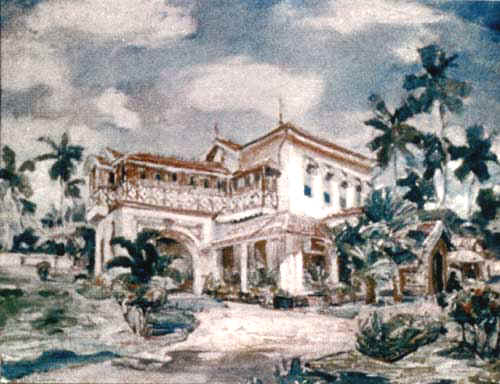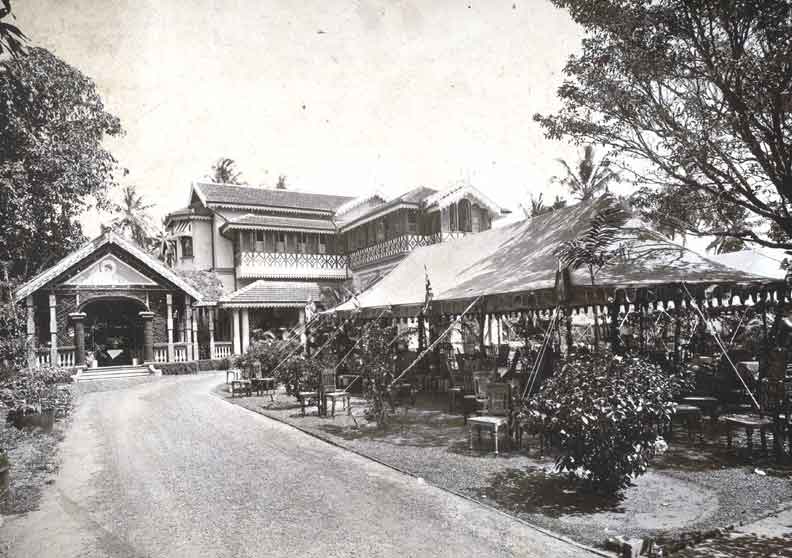 |
| Arcadia as painted in the early 1930’s by Otto Scheinhammer (see footnote 2) |
ARCADIA(1) ; A search of an Encyclopedia may describe it as a mountainous region of ancient Greece, traditionally known for the contented pastoral innocence of its people or any real or imaginary place offering peace and simplicity. Obviously it would have been the latter that came to the mind of the person who built this magnificent house in the vicinity of Alexandra Place and Browning Street, (now known as Rosmead Place). The house would have been built by W. A. Fernando, a wealthy Plumbago Merchant of the 19th Century, for his only daughter Evangeline. Edmund Clarke de Fonseka married Evangeline Fernando and joined his father-in-law in the Plumbago business.
W. A Fernando was a wealthy Plumbago Merchant and a Singhalese pioneer of the Plumbago industry, who setup as a merchant in this commodity in 1854. The production of Plumbago (graphite) was exceptional as being one of the few industries controlled by local Singhalese rather than foreign owners. W. A. Fernando owned some of the largest and the best Plumbago mines in this country. The Plumbago produced from these mines was transported in his own carts to the nearest railway station and shipped to Colombo. Once in Colombo it was taken to his sorting/packing stores at Rosmead Place. The house ‘Arcadia’ was built adjoining this stores.
Arnold Wright makes the first mention of this house in the book ’20th Century Impressions of Ceylon’. The house is referred to as the residence of Mr. Edmund Clarke de Fonseka, a Proctor of the District Court of Colombo, and son in law of Mr. W. A. Fernando.
With the death of Mr. Fernando in 1901, the property and the businesses passed into the capable hands of E. C. De Fonseka. The house became the venue for many memorable family events and weddings. The two beautiful photographs found at the bottom of this page, were both taken at weddings, although a few decades apart. The grandeur of this house is beautifully illustrated in these two photos.
E. C. De Fonseka. The house became the venue for many memorable family events and weddings. The two beautiful photographs found at the bottom of this page, were both taken at weddings, although a few decades apart. The grandeur of this house is beautifully illustrated in these two photos.
It is said that in the early period this property was over five acres in extent and extended from near the end of the present ‘Odel’ fashion store, up to Rosmead Place. By the 1930’s only around two acres surrounding the house remained, the stores complex being sold with the collapse of the Plumbago Industry. Although the house is mentioned as having situated at Rosmead Place, it faced Alexandra Place, and the driveways of the house opened up into this road.
The property in later years was blocked and divided among the descendants of E. C. de Fonseka. With the severe restrictions placed on land ownership by the Sirimavo Bandaranayake regime, most of these blocks went out of the family. Today none of the descendants own any part of this property. The once beautiful edifice is no more. The part of the property that housed the stables, later converted to a house (No 5, Arcadia Gardens) was with the family till recent times. The rest of the original property contains multi-storied shops, a service station and private houses.
The grandeur that was ‘Arcadia’ is no more. But the legacy of ‘Arcadia’ remains to date in the name given to the access road, for these blocks of land. It is still called ‘Arcadia Gardens’ and could be found at the top of Rosmead Place.
- Arcadia: a region of ancient Greece, in the middle of the Peloponnesus, without a seaboard, and surrounded and dissected by mountains. The Arcadians, relatively isolated from the rest of the world, lived a proverbially simple and natural life.
- The Oil on canvas painting displayed above has been done by Otto Scheinhammer (1872 – 1982). OTTO SCHEINHAMMER was born in Munchen (Munich). After his two-year war service he took lessons in art. From 1924 to 1926 he traveled in Europe and held art shows in major cities like Amsterdam and Berlin. In 1927 Otto was introduced to E C de Fonseka who was in Germany to meet a Plumbago buyer. They became friends and Otto was invited to Ceylon. He visited Ceylon the same year and spent several months as their guest. The above painting was done during his stay at Arcadia during this visit. Otto did another trip to Ceylon a few years later.
There is an Art gallery in Augusberg in Germany devoted to German post-impressionist Otto Scheinhammer and one section has pictures painted in Ceylon. Martin Russell ‘s book on George Keyt mentions Otto as the first painter to show nude paintings in Ceylon. He had the patronage of the German Consul. After this, Keyt too showed his own nude “Govindamma” at an exhibition the next year.
Ref: The Anton Wickremasinghe Collection by Sita Jayawardana. Times of Ceylon Annual 1967Most of Scheinhammer’s initial work on Ceylon was destroyed in a fire and the landscape on exhibit presents a rare opportunity to view a work of art by this acclaimed master.
Events of the week – A unique collection on display, Island of 2000/11/12

